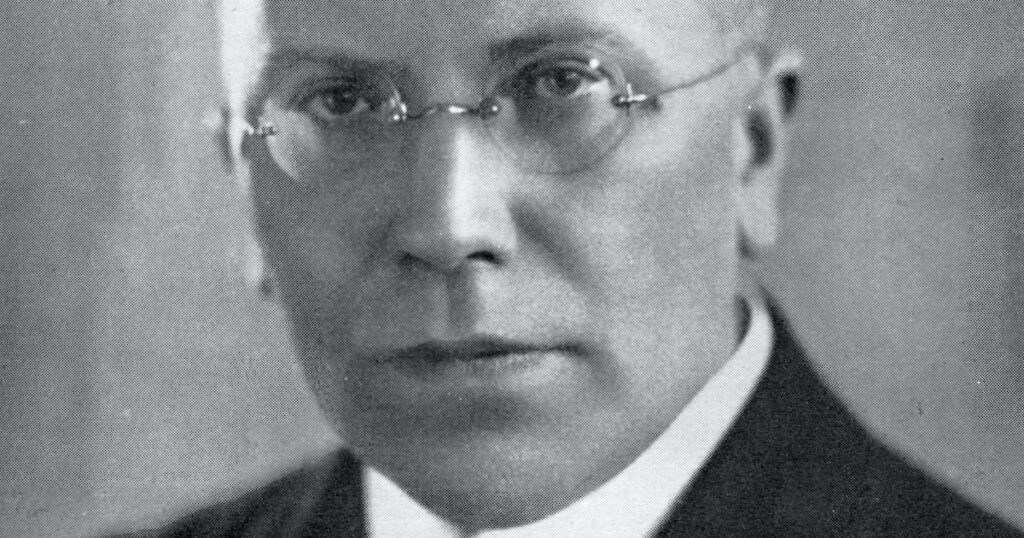It was 125 years ago, on July 17, 1895, that a son was born to a German pharmacist and his wife in a small town in Thuringia. They named the baby Hermann Otto Erich Sasse. Hermann’s life spanned the first three quarters of the 20th century and was a testimony to faithful endurance under the cross. From his story, we may learn something about steadfast confession and perseverance in our own trying times.
In 1913, at the age of 18, Sasse went to the prestigious University of Berlin, which was a showcase of theological heavyweights: Adolf von Harnack, Karl Holl, Reinhold Seeberg, Julius Kaftan, Adolf Deissmann and others.
The Great War
Three years later in 1916, Sasse interrupted his studies to enlist in the German army with the rank of sergeant. His experiences in World War I shaped the course of his life. His infantry regiment was sent into the Battle of Passchendaele in Belgium, one of the bloodiest battles of the war. Out of his regiment of 150 soldiers, only six survived. Confronted with the brutality and carnage of war, Sasse was driven back to the realism of Luther’s writings regarding human sinfulness and God’s mercy in the cross of Christ. Sasse later remarked that, for him, liberal theology died in the trenches of World War I. Liberalism’s optimism about a new world, a kingdom of God on earth created by human beings who lived by an ethic of brotherly love under the fatherhood of a distant God, proved to be an illusion.
After the Great War, Sasse returned to Berlin where he completed his doctorate, was ordained into the ministry in 1920, and was married to Charlotte Naumann in 1924. The year after his marriage, Sasse came to the United States for a year of postdoctoral studies at Hartford Seminary. While at Hartford, he read Wilhelm Loehe’s Three Books About the Church,and by his own admission became consciously Lutheran in his theology and confession.
While in America, Sasse observed how American churches were generally committed to a non-dogmatic form of Christianity that avoided the question of the truth (see Hermann Sasse, “American Christianity and the Church,” in The Lonely Way, vol 1 [St. Louis: CPH, 2001], 23–60). He was encouraged, however, that Lutheran churches in the United States had for the most part avoided this temptation. He noted with appreciation that the Missouri Synod promoted a rigorous commitment to doctrine and exhibited an active congregational life.
Ecumenical dialogue
Back in Germany, Sasse was active in responsible ecumenical dialogue. These discussions put Sasse in contact with Christians from all over the world. Sasse did not see ecumenism as a vehicle for compromise, but for confession. Even after the German government put travel restrictions on Sasse, he still traveled to England in 1936 with forged travel permits to meet with the Archbishop of York.
Sasse was one of the first Lutheran theologians to speak out against National Socialism. As the editor of a church newspaper, in 1931 he wrote a strong critique of attempts to manipulate the church for political purposes. Sasse joined Dietrich Bonhoeffer, Georg Merz, Friedrich von Bodelschwingh and Wilhelm Vischer to draft the Bethel Confession in 1933, a clear Lutheran statement in opposition to National Socialism. Sasse participated in the Confessing Church that stood against Hitler. He eventually broke rank with Bonhoeffer in 1934 by refusing to endorse the Barmen Declaration, which was crafted by the Reformed theologian Karl Barth. Sasse identified the Barmen Declaration as unionistic, as it set aside critical differences between the Lutheran and Reformed confessions of the 16th century, forming a false basis for Christian unity.
Sasse was a staunch Lutheran, uncompromisingly committed to the Book of Concord. He found in the Lutheran Confessions sufficient reasons for speaking against National Socialism. The Lutheran teaching of the two realms or “two kingdoms” did not lead Sasse to quietism or withdrawal, but was the very framework by which he diagnosed Hitler’s perverted claims as idolatry, to be resisted for the sake of the confession that Jesus is Lord.
In 1933, Sasse accepted a call to the theology faculty at the University of Erlangen where he served until 1948. In 1948, Sasse resigned from the Bavarian Church, as it had compromised the confession of the Lord’s Supper by entering into a union with churches that were the fruit of the Prussian Union of the 19th century, which brought together Lutheran and Reformed churches in a single body. Just after the end of World War II, LCMS President John W. Behnken visited Erlangen. He became Sasse’s friend and the two remained in correspondence for the rest of their lives. Sasse was deeply interested in the Missouri Synod, and he saw in it the last great hope for confessional Lutheranism. In 1949, Sasse took up work as a professor of church history at Immanuel Lutheran Seminary in Adelaide, Australia. He remained in Australia until his death in 1976.
Theologian and letter writer
Geographically separated from colleagues and library resources in Germany, Sasse was unable to continue with some of his research interests, including additional contributions to Kittel’s monumental Theological Dictionary of the New Testament. But Sasse was not idle; he was busy with correspondence to both Lutheran and non-Lutheran theologians and church leaders all over the globe. His mimeographed “letters to Lutheran pastors” served as a vehicle to teach and encourage those that Sasse dubbed as “lonely Lutherans” who often served in isolated places or struggled as confessional witnesses within church bodies that were veering away from the solid confession of the Gospel. In time, these letters were published in various journals and collected into books. They remain instructive for Lutheran pastors and laity in our own day.
Much of Sasse’s attention was devoted to the Lord’s Supper, for Christ’s body and blood are at the heart of the church’s life. Where the presence of Christ’s body and blood is denied and the Supper set aside, the Gospel is polluted and the very life of the church is endangered. As a church historian, Sasse could examine current trends in light of the church’s past. Sasse recognized that the theologian should not only teach but also call the church to repent and return to the Holy Scriptures. Sasse reclaimed great theological truths from Luther not just because they were from the Reformer, but because they were the truth from the Holy Scriptures. He sharpened and accented such themes as the theology of the cross, noting that everything the church does must be filtered through the cross lest we fall prey to a theology of glory that rests on the wisdom of human beings rather than on the wisdom of Christ.
What does it mean to be Lutheran?
Perhaps more than any other theologian of the 20th century, Sasse gave an articulate and fulsome answer to the question “What does it mean to be Lutheran?” For Sasse, being Lutheran was more than a commitment to Luther as a hero of church history or a cultural or denominational identification. Lutherans confess the Gospel of Jesus Christ according to the Book of Concord because it is in agreement with the Holy Scriptures.
Hermann Sasse also recognized that to confess the cross is to bear the cross. Gifted by our Lord with the truth of salvation through faith in Christ alone, and placed into a particular slice of human history, Sasse was a faithful witness to the cross of Christ in his teaching and writing but also in a life that brought him into conflict and suffering on account of the Gospel. Sasse recognized that the church of Jesus Christ lives neither in pessimism or optimism but in hope that gives us courage to confess our crucified and risen Lord, who remains with His church to the end.






Though Sasse is right, the LCMS seems to be sitting on the sidelines as candidate Trump has already stated he would be an authoritarian from day 1 if elected. From where I sit in my congregation people are supporting Trump despite his authoritarianism while hoping Christian Nationalism makes Lutherans safe from the government. That never happens.
If you haven’t listened to Trump’s comment, you should. The comment was made obviously in humor and in jest. Let’s be a little more cautious in our rhetoric lest we further overheat the situation.
Amen!
http://www.cls.org.tw/lib/logia/Journals/04-4%20Sa sse.pdf
Most of you have probably read the fine Logia issue linked above cover to cover. Pretty much any questions I have had in the past about the trajectory of contemporary Missouri theology were definitively answered in these pages. In short, we are no longer strictly the synod of Pieper, but also of Sasse.
Norman Nagel answered my question about the dismissal. Yes, it’s different now. The 1539 Saxon liturgy read:
“The body of Lord Jesus Christ, given into death for you, strengthen and preserve you in the faith to eternal life, amen.
“The blood of our dear Lord Jesus Christ shed for your sin, strengthen and preserve you in true [recht] faith to eternal life, amen.”
The Sasse-inspired 1973 LCA dismissal, from which our contemporary dismissal comes, reads instead: “The body of our Lord Jesus Christ and His precious blood strengthen and preserve you in body and soul to life eternal.”
The change came about due to Sasse’s study of doctrinal and liturgical history, following Lietzmann’s “Messe und Herrenmahl” of 1926. Ignatius of Antioch had confessed the sanctifying property of the body and blood, which had come through early Christian liturgies via John 6. Nagel quotes Luther in the LC and FC SD VII’s approval of Ignatius to identify this as also the correct confessional view. Sasse had a dim view of the progression of Aristotelian Lutheran orthodoxy, which led by Hollaz’s day to “a view of the sacrament any Calvinist could accept.” Hence, the rectification of the dismissal in our own day. This also explains why one can hear the claim that we are more confessional now than at any point since 1580.
Pieper, of course, followed the course set by Lutheran scholasticism, which Sasse claims was problematic even in Pieper’s day. Elert and Schlink had the compelling answers for contemporary Lutheranism, not Pieper. Pieper did not have the same views on the sacrament, the church, and inerrancy as Sasse and the German Lutherans. Hence, at Bad Boll and beyond, Missouri was won over by the intellectual force of the contemporary German theologians. It is still an uneasy balance, as Sasse predominates in the above differences among confessional theologians today.
Sieck and the other CSL professors who balked (but acquiesced) to Sasse teaching there based this on his pessimism and the above listed theological differences. What’s interesting about Nagel’s article is that there is no reflection on why the Saxon dismissal reads as it does. Here the emphasis, as in the early LCMS, is on faith as strengthened and preserved through the pledge and seal of the body and blood given for the world’s forgiveness and salvation. The body and blood are a Testament, as Chemnitz’s definitive book on the Supper states over and over. And so Nagel’s quotes of Ignatius et al. can be read in a Lutheran sense, as medicine of immortality, but also in a catholic Sasseian sense as “eating the flesh in the sacrament forgives sins and raises you to eternal life by virtue of the flesh.”
One way that Nagel/Sasse come to this view as confessional is through select approving quotes in the LC and SD. But this is akin to reading the approving quote of the Wittenberg Concord in SD VII and not realizing that there is a Bucerian and a Lutheran reading of the WC. Similarly, Melanchthon is not defending transubstantiation when he approves of the Roman and Greek understandings of the Real Presence in the Apology. Rather, it is part of a larger, longer argument. An argument with ultimately different conclusions.
As the 1995 Logia shows, the legacy and theology of Hermann Sasse shaped and continues to shape the views of the confessional wing of the LCMS today. I would have to revise my earlier statement that Pieper is the most influential theologian of the 20th century. Pieper is the culmination of orthodox LCMS Lutheranism. Sasse, however, reigns as the 20th century Lutheran theologian who guides our confessional thinking today.
Thank you so much for your wonderful article. In these days of confusion and fear, the one thing we need is Jesus. Hermann Sasse confessed that only a strong belief in God through the Holy Scriptures and Sacraments
is our strength and salvation. We need to be reminded daily.
Peace,
Kathleen Logel
Muscatine, Iowa